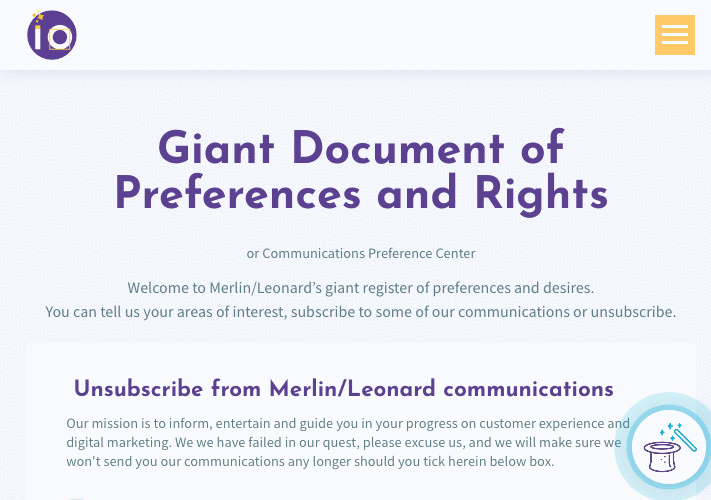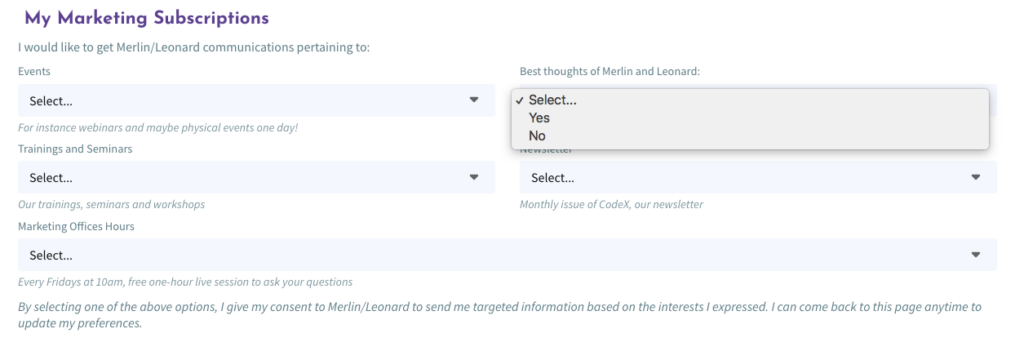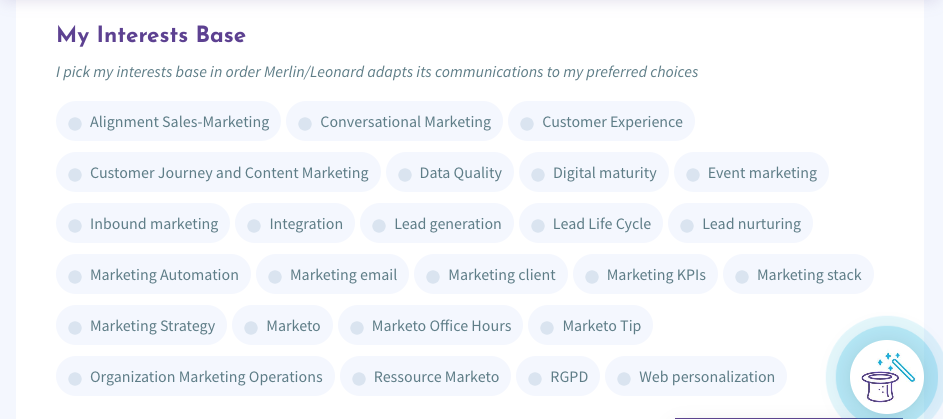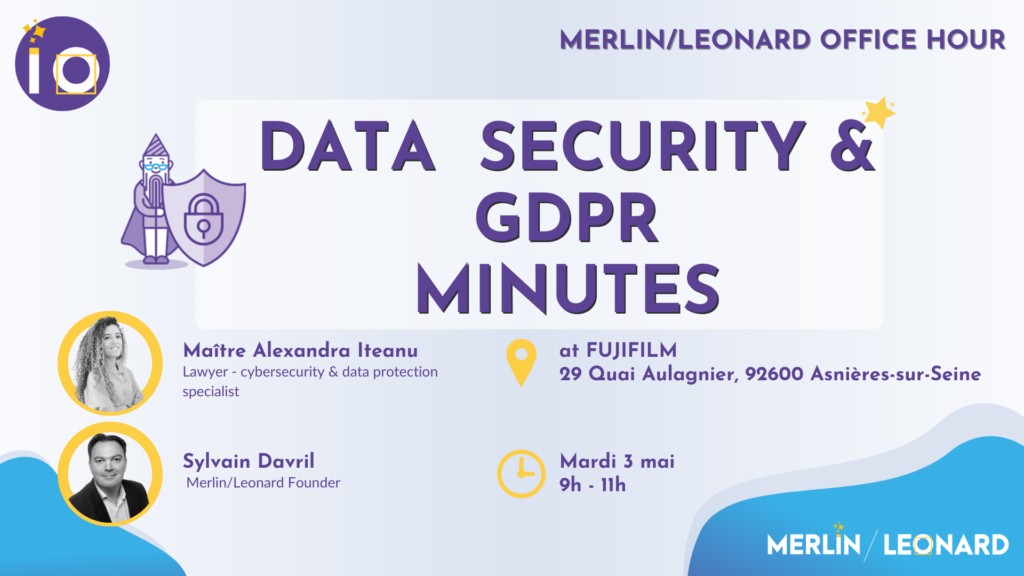The General Data Protection Regulation – GDPR – has been subject to many interpretations even before it came into force in May 2018.
One thing remains certain: obtaining GDPR consent from your prospects is now key.
At Merlin/Leonard, we’ve consulted extensively with our lawyers. And we have assisted more than twenty clients in setting up a GDPR-compliant preference center.
This varied experience has convinced us that a preference center, far from being a thorn in the side, can be a real boon for companies that want to build a lasting relationship with their customers and prospects based on trust.
Here are five ideas that summarize what our experience has taught us.
1. There is no such thing as the perfect preference center / GDPR consent model
If you’re looking for a template to copy, you’ll be disappointed.
That said, we’re pretty proud of our preference center, as you saw at our Office Hour on this topic (if you missed it, the replay is here).
It’s a good example but not a universal template because the elements of the form need to reflect the specifics of your offerings and communication methods.
So it’s up to you to determine which elements you’ll need to collect consent for (see point 4 below) or which ones just deserve an indication of areas of interest (see point 5).

2. A relationship based on trust
The metaphor between relationship marketing and married life is inescapable.
You could say that your customers and your company are in a relationship between consenting adults that will hopefully last longer than a one-time transaction.
For the relationship to endure, everyone must abide by the terms of the contract:
- one entrusts his or her personal data and agreement to receive communications;
- the other commits himself to hold on to this data as the apple of his eye and not to communicate anything without this agreement – and, above all, not to communicate anything in case of disagreement (see our previous article on this subject).
This marriage contract is the preference center.
3. Between total consent and total refusal, propose alternative ways
The opt-down: I want this but not that
If you can’t get your customers and prospects to opt in, you can avoid the global opt out by offering a selective opt down.
Avoid the unsubscribe divorce by offering an extra level of granularity: okay, I’m sick of your event invitations but I’m willing to keep receiving your newsletters (I’m willing to keep hearing about your day at the office if you’ll dispense with Sunday lunches at your mom’s house).
This is called compromise, a real pillar of the relationship.

I need a break
Another way to avoid a break-up is to propose a temporary separation: for three, six or nine months, for example, the customer or prospect no longer wishes to receive anything but agrees to be automatically re-subscribed at the end of this period, during which he or she will have had time to “take stock”, to determine if he or she misses your communications

4. Collect GDPR consent by campaign type rather than by offer category
The question companies often ask is: do I need to collect consent for each family of products and services?
The answer is yes, if your company operates in silos and remains product-oriented (no judgement, right).
But it is still necessary that customers and prospects do not miss an offer that could have interested them at the time of their choice.
However, if your company is customer-oriented, your communications will necessarily be transversal and your speeches will often go beyond the simple framework of the offers.
In this situation, don’t lock yourself into product consent and instead ask your customers and prospects what types of communication they would prefer to receive: invitations to events, announcements about offers, feature articles…
This is the example above “GDPR consent optin optout purposes”.
This gives you the freedom to communicate about all offers or none in particular, and of course, within the chosen communication channels.
We recommend that you treat the offer categories as areas of interest, not subscriptions: the customer will be able to tick off the subjects that interest him/her without this being taken as consent in the strict sense.

5. Use Select/Yes/No lists instead of check boxes
With a checkbox (or Boolean field), the absence of an answer will be considered as a refusal.
With a value list, in addition to Yes and No, there is a third possible response: no response.
We believe that there is a significant difference between clients who have actively indicated their refusal to communicate and those who have not yet indicated their preference.
Thus, we recommend collecting consent (by communication mode, if you follow) via Yes/No lists and handling topics of interest (such as offer categories) via checkboxes (see example above).
It will be possible to send invitations to events to those who have agreed to receive them as well as to those who have not yet given their opinion, but not to those who have specified that they do not wish to receive them.
This rather flexible interpretation of the opt-in rule has been confirmed by the CNIL for business-to-business (B2B) services.
Think of your preference center with your future marketing actions in mind, and make it the basis of a win-win relationship with your customers.
Design your program and integrate it with your CRM so that your customers’ wishes are really taken into account.
In this video, you will find a lot of tips to make your preference center successful.
How Merlin/Leonard can help you with your GDPR consent issue
When we help a company create its preference center, we do it in three steps:
- On a paperboard, definition of the elements of the preference center: which subscriptions, which areas of interest, which possibilities for the customer to update his personal data, which temporary suspension periods… in this phase, it is necessary to put oneself in the customer’s shoes, while ensuring that marketing will be able to meet the expectations expressed.
- In CRM and/or Marketo, agree on the fields to be created or modified, their format and the impact of synchronization between the different systems that will use them.
- In Marketo, create the form and the smart campaigns that underlie all the actions triggered by the choices made in the preference center.
This last phase is more complicated for our international customers operating in countries, such as Germany, where the double opt-in rule is in force. In these countries, the consent of customers who have answered “yes” in the preference center will only be recorded after they have also clicked on a link in a confirmation email.
It is true that the General Data Protection Regulation was the result of an effort to harmonize the rules within the European Union. But pre-existing local rules, where they are stricter, continue to apply!
















